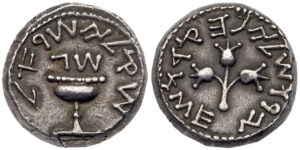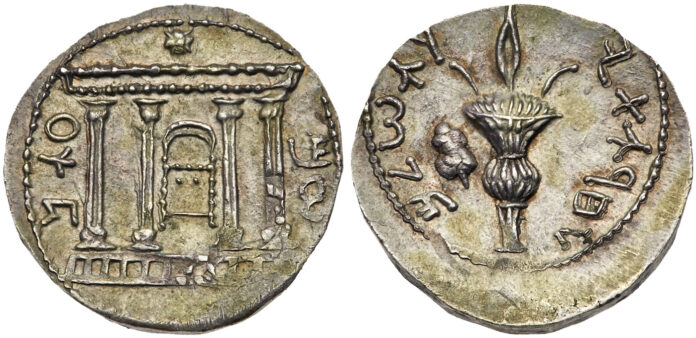Mel Wacks Collection of Coins From Ancient Judaea at New York Sale
Like the ad slogan: “You never actually own a Patek Philippe. You merely look after it for the next generation,” Mel Wacks has indicated that he has gained great satisfaction in owning 2,000 year-old Judaean and related coins for over 50 years – and now it is time to pass them along to the next generation. Mel goes on to say that “There is nothing quite as thrilling as holding a coin in your hand that could have been used by the fighters for Judaean independence in the Maccabean uprising, or during the First or Second Judaean Revolts. Even the Roman coins inscribed ‘Judaea’ or a variant thereof are proof that this was the ancient Jewish homeland.”
The following coins are among those that will be featured by Goldberg Auctioneers at the Upcoming New York International Numismatic Convention, January 14-16, 2020. The historical backgrounds have been taken largely from Mel Wacks’ Handbook of Biblical Numismatics, which is available free online.

First Judaean Revolt, Shekel (Silver), “Year 3,” 68/69 C.E.
When the Jewish Revolt broke out in 66 CE, the revolutionaries quickly captured the holy city of Jerusalem, thus assuring them access to the great Temple for religious purposes and to its vast treasury as well. From the silver therein – presumably consisting of Tyrian coins paid in taxes over the years – they struck the most famous of all Jewish coins – in shekel and half shekel denominations. These handsome coins are the first truly Jewish silver coins. They feature a chalice on one side with the year of the revolt above, surrounded by the ancient Hebrew inscription “Shekel of Israel.” Three budding pomegranates are featured on the reverse, with the inscription “Jerusalem the Holy.”
Purchased from Hans Schulman Auction, 5/5/63.

Judaea Capta, Vespasian, Aureus (Gold), after 70/71 C.E.
Soon after the Temple at Jerusalem was razed by the victorious troops led by Titus in 70 CE, his father – Emperor Vespasian – launched an extensive issue of coins commemorating the hard fought Roman victory over the tiny Jewish nation. The design elements of this gold aureus are a palm tree and a seated figure of a female (allegorical representative of Judaea) in an attitude of mourning. The depiction on this coin may reflect the prophesy of Isaiah (c. 700 BCE): “For Jerusalem is ruined, and Judah is fallen … Thy men shall fall by the sword and thy mighty in the war. And her gates shall lament and mourn, and she being desolate shall sit upon the ground” (Isaiah 3:8, 25-26).
Purchased from Jacques Schulman, date unknown.

Adventui Judaea, Hadrian, Sestertius (Bronze), c. 134-8 C.E.
The Roman Emperor Hadrian (117-138 CE) visited many of the Roman provinces, including Judaea in 130 CE. Immediately, the rumor spread among the Jewish inhabitants that the Emperor, one of the great ancient builders, intended to rebuild the Jewish Temple in Jerusalem. He did intend to build a temple on this holy site … however it was to be a pagan Roman temple dedicated to the god Jupiter (Zeus). Leo Kadman writes: “The Jews watched the stones of the Sanctuary being used to erect temples for heathen gods. No choice was left to them but to interrupt the building of the Roman colony by force of arms before it was completed” (The Coins of Aelia Capitolina).
At the age of 60, Hadrian returned to Rome from his travels, and began to strike coins to commemorate his visits to the empire’s provinces – Egypt, Macedonia, Spain, etc. – and the Judaean visit was no exception. His ADVENTVI AVG IVDAEA bronze sestertius, issued sometime between 134 and 138 CE, shows the Emperor receiving a Jewish woman and two children who carry palm branches; in the background, a bull appears next to a sacrificial altar. (#95) The altar was a reference to the god Jupiter Capitolinus, to whom Hadrian had dedicated his new pagan temple. Hadrian renamed Jerusalem as Aelia (his family name) Capitolina.
Purchased from Christian Blom, 3/73.

Second Judaean Revolt, Sela (Tetradrachm) (Silver), “Year 3,” 134/5 C.E.
The overstruck silver tetradrachms (called “sela” in the Mishnah) are among the most religiously significant coins issued by the ancient Jews, since the Holy of Holies of the Jerusalem Temple is depicted, along with the Ark – that had held the two tablets of the Ten Commandments in Solomon’s time. Beginning in the second year and continuing into the final year, a star appeared above the Temple on many coins, likely alluding to Bar Kochba’s nickname “Son of the Star.” During the third year of the revolt, “For the Freedom of Jerusalem” was inscribed around the Temple.
Purchased from Bank Leu Auction, 12/7/66.
All of the coins in the Mel Wacks Collection, and other lots can eventually be viewed and bid online on the website of Goldberg Auctioneers.
You can get the printed catalog free of charge if you call 800-978-2646 or write an email and mention that you read about this sale in Coins Weekly.





